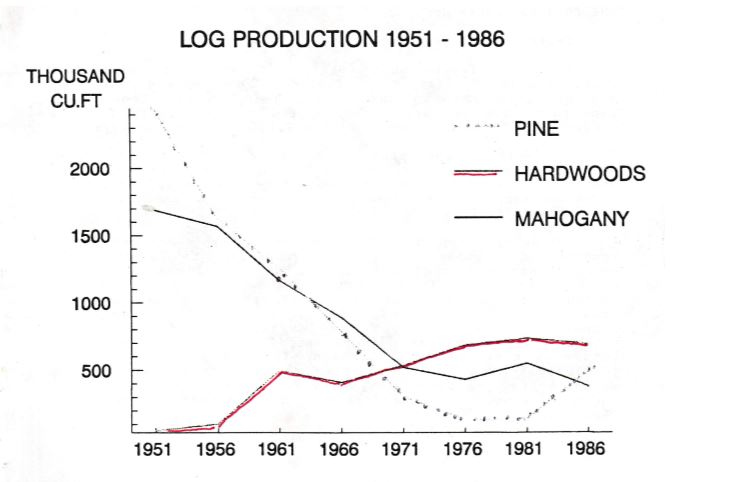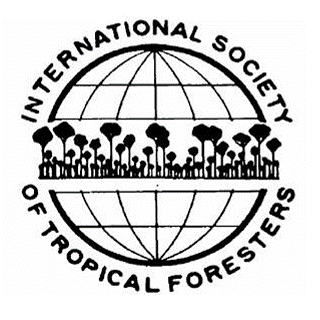The Belize Tropical Forestry Action Plan: An Education
Nick Brokaw
In 1988, I was fortunate to become a member of the Tropical Forestry Action Plan (TFAP) team for Belize, Central America. I worked with a group of forestry experts and saw much of Belize during this time. The experience taught me that tropical forestry can be sustainable, in principle, and showed me how complex forestry truly is.
Organized by FAO (Food and Agriculture Organization of the United Nations), TFAP was a pan-tropical program created to assist countries in studying and advancing the state of their forestry. Forestry in Belize was in decline at the time (Fig. 1), so the Government of Belize asked the UK to organize a Belize TFAP that could assess the conditions and provide targeted recommendations.

Members of the TFAP team came from Belize, USA, UK, Canada, and Turkey, and were mainly sponsored by development agencies of those countries. Each team member focused on their individual specialties, such as forest management, forest economics, forest industries, land use, institutions, and environmental conservation. As a forest ecologist, I had been sponsored by the US Agency for International Development and my specialty was conservation.
The team worked in Belize during May and June of 1988. Our headquarters for the duration of our assignment was the Bull Frog Inn in Belmopan, the capital of Belize. We all traveled to do archival and field work to get the background for our assessments and recommendations, but whenever we weren’t on the road, the team would meet each day at the Bull Frog to share meals and discuss our progress.
My archival work was to study conservation policy and progress in Belize using documents supplied by the Belize Forest Department, other government offices tasked with resource management, and conservation NGOs. My field work was to visit protected areas and speak to Belizean conservationists. For practical reasons, I was paired with Ozzie Bender, a veteran forest industries consultant from Tacoma, Washington. Ozzie had worked in 35 countries and was a deep source of wisdom and stories. He and I drove around Belize visiting protected areas, offices, logging sites, sawmills, furniture makers, and even a match company (Figs. 2-8).






prasinus), (Toucan Match Co., LTD, Belmopan, Belize).

After leaving Belize, the TFAP team met again in September 1988 at the Oxford Forestry Institute in the UK to integrate our reports. We submitted the 272-page (A4 paper) final report to the Government of Belize the following year, in September 1989.
My report described laws, regulations, and conventions governing environmental conservation; enumerated the public and private protected areas; provided suggestions for studies, a data center, new reserves, and improved management; and gave results of a “gap analysis,” which showed what habitats were not protected.
I did the gap analysis by layering a big map of Belize’s protected areas on top of a same-scale map that showed Belize’s 34 major vegetation types, assumed to represent distinctive habitats and constituent organisms. Taped onto a picture window, both layers would be brightly backlit on a sunny day, and I could see which vegetation types were not included in protected areas. The main conclusion of the analysis was that 16 of the 34 types were not protected.
Other reports from the Belize TFAP suggested changes such as using band saws instead of circular saws for milling (to reduce waste), abandoning polycyclic for monocyclic silviculture to favor mahogany (Swietenia macrophylla) regeneration (which does better in large disturbed areas), establishing a series of long-term forest dynamics plots (to assess growth and natural regeneration of multiple species), changes in royalties (stumpage fees; and to increase Forest Department revenue), adding personnel to the Forest Department (to extend expertise and oversight), improved data collection (to optimize wood products output and income), and many others, all in great detail.
There is a lot more to forestry than trees alone. That is what makes it hard to achieve sustainability. But there are clear steps to take toward success so long as we can keep all the parts in mind and remain in pursuit of our goals.
The team also provided an action plan to effect these changes. I helped enact some recommendations, such as the establishment of long-term plots and research on promoting mahogany regeneration. Many of the other changes were also implemented following the TFAP report.
In the end, I got my consulting fee and much more from working on the Belize Tropical Forestry Action Plan. Every step of the way – at the Bull Frog, on the road with Ozzie, and at Oxford – I gained a deeper understanding of industrial, economic, silvicultural, and institutional forestry. It was a course in forestry that greatly expanded my outlook.
There is a lot more to forestry than trees alone. That is what makes it hard to achieve sustainability. But there are clear steps to take toward success so long as we can keep all the parts in mind and remain in pursuit of our goals. ISTF makes these parts of forestry accessible and foments the collective will to continue forward.
For all interested, the conservation section of the Belize TFAP report can be found here.
